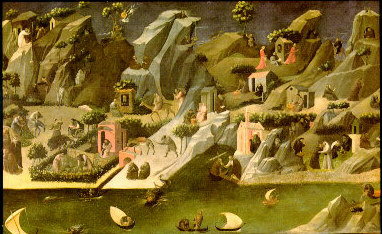Some fine things
Here are some of the finer things in life that I especially enjoy.
I make no claim that this page is organized, consistent, or
constant.
 The Alchemist
The Alchemist
Cornelis Bega: Dutch: 1663: H. Schickman Galery,
N.Y.
Courtesy of Carol L. Gerten Fine
Arts
Click here for a higher-resolution version
of this painting.
This picture is a long-time favorite, partly because this
chap's arena looks
a lot like my own shops and labs. It is likely that the alchemist
is revered and feared as a wizard (technically competent
person) by folks on the outside, even as they sometimes are driven
to utilize his talents. Here he is with his socks
rolled down, engrossed in his technical work amid the tools
and materials of his trade, with little companionship evident or needed.
He personifies,
perhaps, the archetype of the can-do engineer, particularly
those who do experimental research, invent gadgets, or make things.
The art folks can comment on the
composition, use of light, color, and technique. I know that
this is a satisfying, resonant picture. I suppose I identify with this
guy. With a bow to Ecclesiastes, he seems "happy in his labors, for that is
his lot." Lucky chap.
 Battle of San Romano
Battle of San Romano
Paolo Uccello: Italian: c1440: Uffizi, Florence.
Click here for a higher-resolution version
of this painting.
I first saw this picture while visiting the Uffizi Museum in
Florence with my oldest daughter, the art historian. That
experience was a treasure - how often do you get to visit
an art museum with a professional expert who also
happens to be your progeny?
This Uccello picture
caught my attention, for reasons that I did not entirely fathom at
the time, but that seemed to go beyond the fierce
masculine themes of war, death, weapons, and steeds. Recently, I
learned that the picture is one of the earliest and best examples
of the use of the rules of perspective. The lances
are some major elements that delineate the perspective.
But the important point
is that the perspective is established without enslaving the art
to the technical device. Another important development
here, according to my daughter, is the depiction of the horses
as rounded three-dimensional creatures; they are still stylized,
but they have depth and vitality.
 Thebaid
Thebaid
Gerardo di Jacopo Starnina: Italian: c1400: Uffizi,
Florence.
Click here for a higher-resolution version
of this painting.
This painting was also discovered in the Uffizi. The longer you look
the more you see. It's intricacies make it hard to appreciate on
the small screen. We have here a whole mob of hermits or monks going
about various pastoral and aquatic activities in an apparently idyllic
setting.
Then one discovers, maybe with the help of an expert plus access to the
rest of the panels that are housed in other museums, that these
vignettes show us that the life of a religious
hermit is the only way to triumph over death, especially the plague,
which was a main concern of the time. Regardless of the message,
the picture catches the imagination. The original is pretty dark;
I lightened it a smidgen to improve access to the details.
 The Alchemist
The Alchemist
 Battle of San Romano
Battle of San Romano
 Thebaid
Thebaid